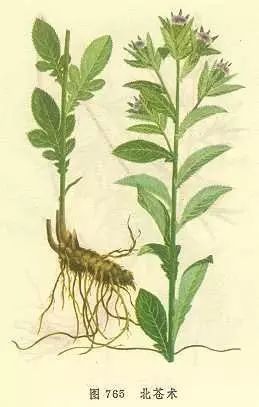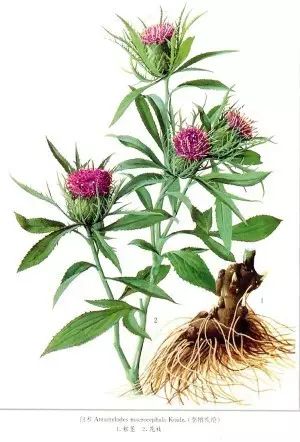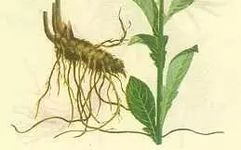Editor’s Note
|
Bai Zhu (White Atractylodes) and Cang Zhu (Atractylodes lancea) were historically referred to collectively as “Zhu”. Over time, they have been distinguished as separate medicinal herbs. The only difference in their names is a single character, which in Chinese can imply color, leading some to mistakenly believe they are the same herb. In fact, while both herbs have the functions of strengthening the spleen and drying dampness, they are used for different conditions. Bai Zhu primarily supplements Qi and strengthens the spleen, making it a key herb for spleen deficiency with dampness; Cang Zhu, on the other hand, is more focused on bitter, warming, and drying dampness, making it suitable for conditions of cold dampness obstructing the middle jiao (digestive system) leaning towards excess. |
Cang Zhu and Bai Zhu are both classified as superior herbs in the Shennong Bencao Jing, which states they “can be used in decoctions. Long-term use leads to lightness of body, longevity, and freedom from hunger.”
Cang Zhu
Cang Zhu is the rhizome of the Asteraceae family plants, such as Cang Zhu or Bei Cang Zhu, which can dry dampness, strengthen the spleen, dispel wind, and relieve cold. The Bencao Gangmu states: “It treats damp phlegm retention, or when combined with blood stasis forms a mass, and for spleen dampness leading to turbid discharge and diarrhea.”

◎ Xu Shuwei’s “Self-Treatment”
Xu Shuwei, a renowned physician of the Song Dynasty, was known for his diligence, often studying late into the night. He had a habit of drinking alcohol before bed, perhaps influenced by the saying, “A sip of wine before sleep can add years to your life.” After several years, he began to experience stomach rumbling, pain in his side, reduced appetite, and occasional vomiting of bitter and sour gastric fluid. In summer, only his right side would sweat, while the left remained dry. What was this strange illness? Xu pondered deeply and sought treatment everywhere, but to no avail, which caused him great distress. Thus, he abandoned the belief that “physicians do not treat themselves” and began to analyze his condition. He concluded that his illness was primarily due to “dampness obstructing the stomach.” Following his principle of “using precise medication,” he selected Cang Zhu as the main herb, using one pound of Cang Zhu powder, 15 jujubes, and half an ounce of raw sesame oil to make small pills, taking 50 pills daily. He gradually increased the dosage to 100-200 pills per day. After several months of treatment, his strange illness gradually improved until he was cured.
Why did Cang Zhu have such a remarkable effect on Xu Shuwei’s strange illness? It turned out that Xu’s fondness for alcohol had harmed his spleen and stomach. A deficiency in the spleen leads to an inability to transform water and dampness, causing “dampness to obstruct the stomach,” which resulted in the symptoms of stomach rumbling, lack of sweating on the left side, and vomiting gastric fluid. The spleen belongs to the earth element, which prefers warmth and fragrance. Cang Zhu has a fragrant aroma, is pungent, warm, and bitter, and enters the spleen and stomach meridians. The compatibility of the herb with the symptoms is evident. Cang Zhu can awaken the spleen and transform dampness, while dampness is a yin pathogen that can be transformed with warmth. Xu Shuwei’s accurate diagnosis and precise selection of herbs, along with his commitment to long-term treatment and gradual dosage increase, were crucial. He understood that dampness is sticky and difficult to eliminate quickly. Only through persistent treatment and gradually increasing the dosage could he build up the medicinal power in his body to ultimately overcome the dampness.
◎ Cang Zhu for Treating Rheumatism
The primary function of Cang Zhu is to strengthen the spleen and promote the transformation of dampness. Its strong pungent flavor can dispel wind and cold, making it commonly used in Traditional Chinese Medicine (TCM) for treating rheumatism.
In TCM, rheumatism is referred to as Bi syndrome, which occurs when the three pathogenic factors of wind, cold, and dampness combine to invade the body. Rheumatism can be classified into cold and heat types, but Cang Zhu can be used to treat either type.
Here is a small prescription for treating rheumatism: use 30 grams of Cang Zhu, 10 grams of Gui Zhi (Cinnamon Twig), and 30 grams of Tou Gu Cao (Drynaria fortunei), boil in water, and soak the painful area with the decoction. After soaking, a towel can be dipped in the medicinal liquid and applied to the painful area.
◎ Cang Zhu for Treating Diabetes
In TCM, high blood sugar is referred to as “Xiao Ke” (wasting thirst), which corresponds to modern diabetes. TCM classifies diabetes patients into water-damp type and yin deficiency type. Patients with the water-damp type typically have a white tongue coating covering the entire tongue. The yin deficiency type presents with symptoms such as a red tongue, thin and rapid pulse, frequent thirst, and obesity. Patients with the water-damp type are particularly suited for treatment with Cang Zhu.
Shanghai’s veteran TCM physician Chen Shusheng summarized a prescription using Cang Zhu to eliminate dampness and treat diabetes—Cang Xuan Zhi Can. This formula consists of 30 grams of Cang Zhu, 15 grams of Xuan Shen (Scrophularia), along with some silkworm cocoons and 30 grams of black sesame, adjusted according to the patient’s symptoms.
Bai Zhu
Bai Zhu differs slightly from Cang Zhu; Cang Zhu is more drying and is primarily used to eliminate dampness, while Bai Zhu is more focused on strengthening the spleen and is often used for spleen and stomach Qi deficiency. Bai Zhu can supplement the spleen, benefit the stomach, dry dampness, and harmonize the middle jiao, treating symptoms such as weak spleen and stomach Qi, loss of appetite, fatigue, diarrhea, dizziness, spontaneous sweating, and fetal restlessness.

◎ Bai Zhu Resembling a “Ruyi”
How can one distinguish between Cang Zhu and Bai Zhu? Bai Zhu was considered a symbol of good fortune in ancient times due to its beautiful shape resembling a “Ruyi” (a traditional Chinese talisman). Bai Zhu is yellow in color and has a fragrant taste, while Cang Zhu has a more pungent flavor. Cang Zhu is aggressive and does not hold its position; it can “attack” but does not stay in one place. Bai Zhu, however, is defensive and stable. Thus, the combination of these two herbs is very effective.
◎ Bai Zhu’s “Gentleman’s Style”
Bai Zhu’s primary function is in the spleen and stomach, not only strengthening them but also controlling gastric ulcers. Bai Zhu has a bidirectional regulatory effect; when the spleen and stomach function is overactive, Bai Zhu can stabilize it; when the function is low, Bai Zhu can invigorate it.
Many ancient prescriptions include Bai Zhu, with the most famous being the Si Jun Zi Tang (Four Gentlemen Decoction), which consists of Ren Shen (Ginseng), Bai Zhu, Fu Ling (Poria), and Zhi Gan Cao (Honey-fried Licorice). This formula is called the Four Gentlemen Decoction because it supplements the body’s righteous Qi, treating illnesses in a very gentle manner. The philosophy of this formula is to first support the body’s righteous Qi rather than expel pathogens; when the righteous Qi is sufficient, the pathogens will naturally dissipate. The ancients said that if a room is filled with gentlemen, the petty people will not be able to stay. The treatment strategy of Si Jun Zi Tang is to regard the righteous Qi as the gentleman of the body; after supplementing the righteous Qi, the evil Qi will naturally flee.
In TCM, it is believed that “Qi is the commander of blood, and blood is the mother of Qi.” Both Qi and blood are fundamental substances that constitute the life activities of the body. “Qi is the commander of blood” means that Qi can generate and circulate blood; “blood is the mother of Qi” means that blood is the carrier of Qi and can generate Qi. The two are interdependent and mutually supportive. Thus, Qi is very important as it governs the normal functioning of physiological processes in the body. If Qi deficiency occurs, it leads to weakness and fatigue throughout the body. Most formulas used to replenish Qi are based on Si Jun Zi Tang.
◎ Xue Lizhai’s Mastery of Bai Zhu
In TCM, Bai Zhu is rarely used alone; it is often combined with Fu Ling and Ren Shen. A famous physician of the Ming Dynasty, Xue Lizhai, was a court physician. He studied diligently at the imperial medical institution and consistently ranked at the top during examinations, becoming a court physician in his twenties and eventually the head of the institution. He was particularly skilled in Qi supplementation and is regarded as the founder of the “Wen Yang” school.
Xue Lizhai had a patient named Zhu Shao, who presented with a unique condition: a red face and blood in the stool, which could easily be mistaken for a heat syndrome. Many doctors believed he should clear heat, but the medications used had no effect. Xue Lizhai believed Zhu Shao’s condition was caused by Qi deficiency, where the Qi could not hold the blood, leading to continuous bleeding. He prescribed a Qi-replenishing formula, which included Ren Shen and Bai Zhu, along with some warming herbs. After taking Xue Lizhai’s medicine, Zhu Shao’s bleeding quickly stopped.
In TCM, there are two types of Bai Zhu: Sheng Bai Zhu (raw Bai Zhu) and Chao Bai Zhu (fried Bai Zhu). Sheng Bai Zhu has a stronger diuretic effect. For treating gynecological conditions, such as insufficient Qi and blood production, Chao Bai Zhu is generally used because it has a milder effect. Nowadays, many young women suffer from irregular eating habits or dieting, which can harm the spleen and stomach, leading to reduced menstruation or even amenorrhea. In such cases, Chao Bai Zhu can be used to supplement the spleen. Additionally, Bai Zhu has a role in stabilizing pregnancy, but it should be used under a physician’s guidance.
◎ Treating Excessive Salivation in Children with Bai Zhu
Excessive salivation in children is often due to spleen deficiency, which fails to hold saliva, leading to drooling during sleep. In this case, raw Bai Zhu can be ground into powder, and 15 grams can be mixed with a little sugar and taken with water daily.
◎ The Eight Treasures Cake: A Health Recipe from the Qing Palace
The Eight Treasures Cake is a significant health recipe from the Qing Palace. It is said that Emperor Qianlong consumed it almost daily for a period, and research suggests that his longevity was greatly influenced by it. What magical ingredients are in the Eight Treasures Cake? It is actually made from the Four Gentlemen Decoction with additional herbs: Dang Shen (Codonopsis), Bai Zhu, Fu Ling, Shan Yao (Chinese Yam), Yi Yi Ren (Job’s Tears), Qian Shi (Euryale), Lian Zi (Lotus Seed), and Bai Bian Dou (Hyacinth Bean). In the Qing Palace, these eight herbs were used in equal parts. However, in modern usage, we can reduce the amount of Dang Shen slightly while keeping the others equal. When steaming buns, we can also add some powdered Eight Treasures herbs to the flour, which is beneficial for health.
It is important to note that individuals with a particularly red tongue and symptoms of deficiency heat should avoid the Eight Treasures Cake.
|Author Introduction|
Luo Dazhong, pen name Luo Dalun, is a Doctor of Traditional Chinese Medicine, graduated from Beijing University of Chinese Medicine. He is also the chief editor of the Beijing TV program “Health Hall” and a guest speaker on health programs for CCTV, Shandong TV, and Beijing TV. He has published books such as “Ancient Chinese Medicine,” “Divine Doctors and Their Practices,” and “This is Traditional Chinese Medicine” to popularize TCM.
Dr. Luo has been immersed in the study of TCM classics since childhood, actively practicing, and is particularly dedicated to explaining the essence of TCM culture to the public. His online TCM stories have garnered over 1.2 million views, making him popular among young readers. His engaging storytelling of TCM knowledge is rich in health wisdom, earning him recognition as a leading figure of the new generation of TCM practitioners.
Source: Food and Health (2012-7), images from the internet/Edited by: Muzi
» If you find this article valuable, please share it with your friends!
|
One article a day, sharing secrets for nourishing the heart, body, and spirit. TCM treasures, there must be a “treasure” suitable for you! |
Click “Read the original text“, to discover more exciting content…
↓↓↓

